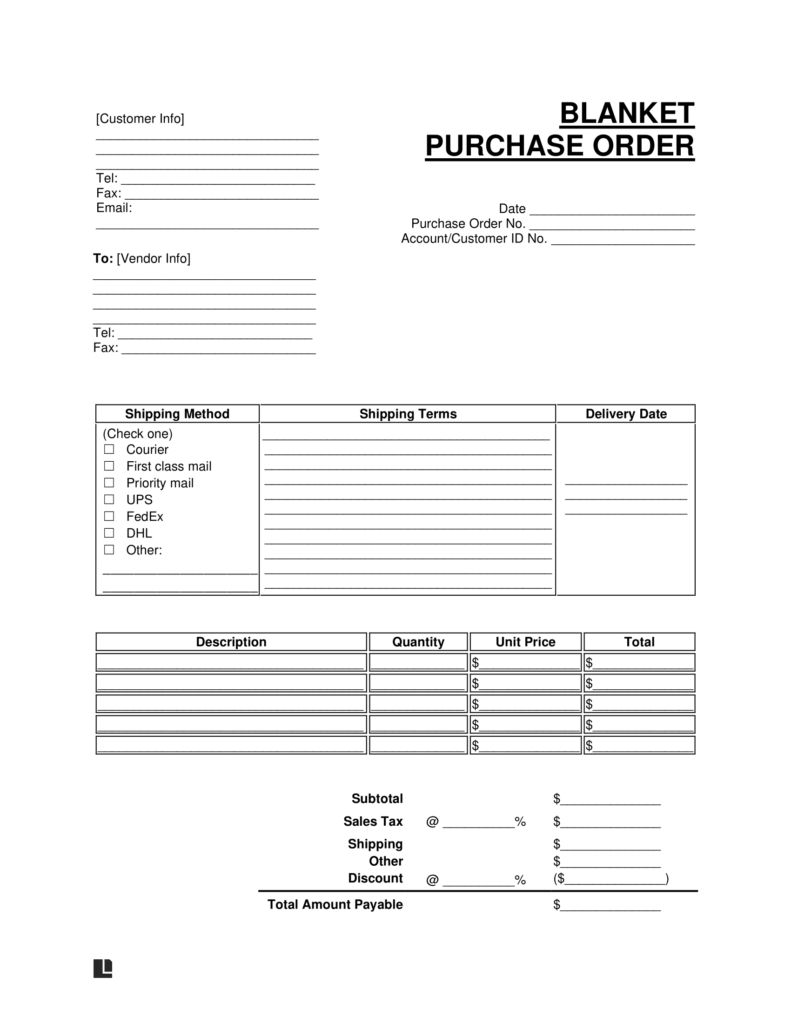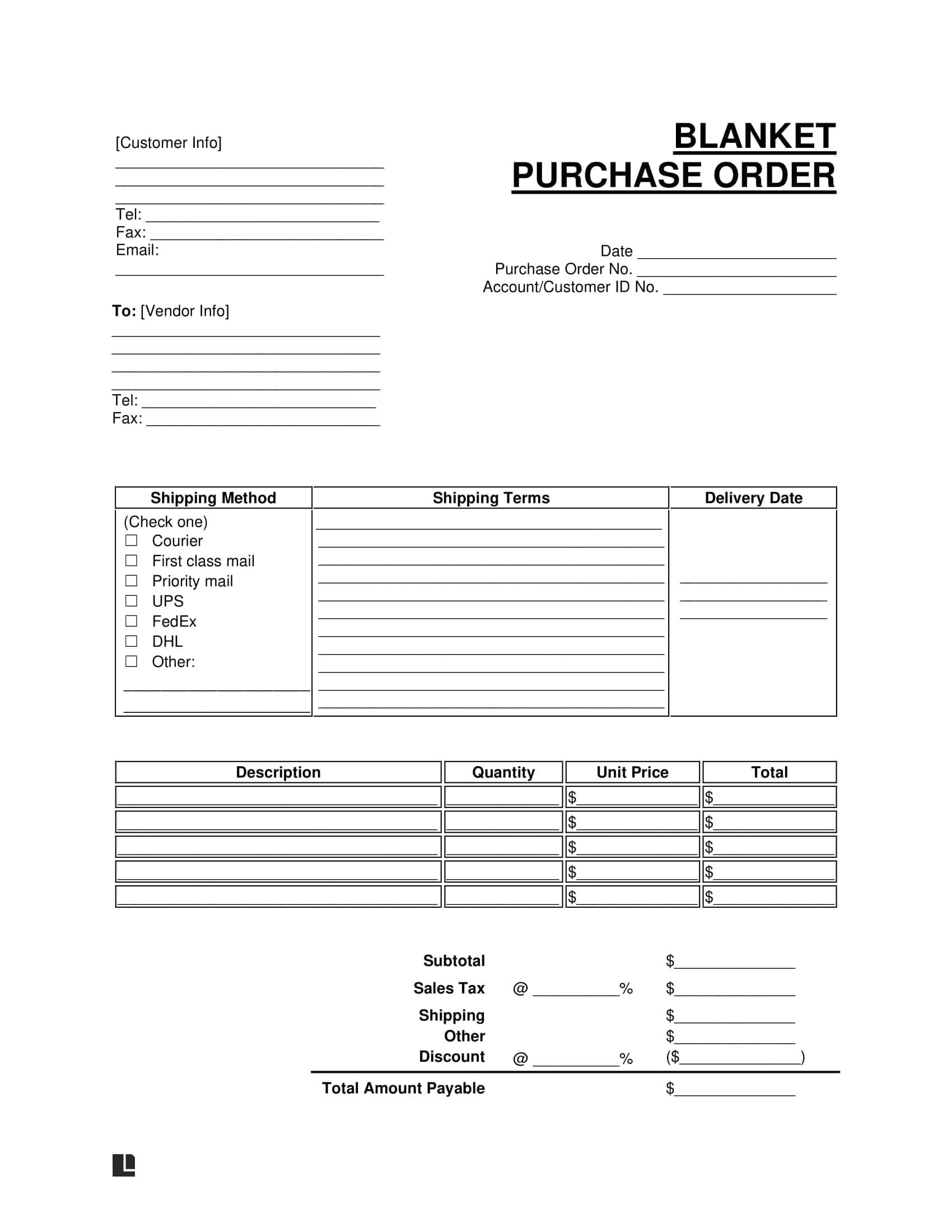A Blanket Purchase Order (BPO) facilitates payments made by a business for the same services and commodities. Also called a standing purchase order, the BPO eliminates processing delays and significantly improves the efficiency of a company’s accounts payable department.
Please continue reading to learn more about the advantages of BPOs and how to use them to streamline your accounts payable, and accounts received systems.
What is a Blanket Purchase Order?
BPOs are legally binding documents that commit buyers to recurring purchases of a specific and fixed amount of products or services from another company.
Analogous to long-term contracts, blanket purchase orders include information like a product or service description, the quantity being ordered and paid for, the date of the transaction, and the PO number.
When suppliers and buyers agree on the conditions, products or services can ship at preset intervals without drawing up new invoices. BPOs provide legal assurance that buyers receive steady deliveries of products at a particular location.
A BPO also provides legal assurance to suppliers that they can expect to sell an exact amount of products in a predetermined period.
When to use a blanket purchase order?
BPOs should only be used when:
- Costs of services or products are expected to remain fixed over an extended time
- Buyers want to purchase bulk quantities of the same product from the same supplier for at least one year
- Both buyers and suppliers can commit to fulfilling a BPO’s requirements according to the time agreement established in the BPO
BPOs should not be used when the cost of a product has a history of instability or the quality of goods or services is prone to ambiguity. Buyers should also beware of signing blanket purchase orders if a seller can’t be fully verified as a trustworthy, credible vendor.
What to Include in a Blanket Purchase Order?
Standard BPOs should include the following:
- Name, address, and contact information of the buyer
- Name, address, and contact information of the seller
- A unique order number for tracking individual business transactions
- Description of goods shipped and purchased (quantity, cost per unit, total price of the shipment)
- Address where the goods are to be shipped
- Delivery date (when the buyer expects the arrival of the goods shipped)
- Billing address (where the invoice should be sent so the purchaser can remit the cost of the shipment to the supplier)
- Signature of the buyer paying for the shipment
- Signature of the seller accepting the validity of the payment
- Order date (date on which the transaction was completed)
Advantages and Disadvantages of a Blanket Purchase Order
While the benefits of BPOs are numerous and varied, there are drawbacks to using blanket purchase orders. Before implementing a BPO for buying or selling transactions, learn more about its advantages and disadvantages.
Advantages of a Blanket Purchase Order
Simplifies the Buying and Selling Process
Instead of constantly dealing with invoices, transactions between suppliers and purchasers are encapsulated in one legal document.
Legal Protection for Vendors and Suppliers
Provides legally protected support for a company’s operational continuity by ensuring the sale or delivery of services or goods.
Fixed Pricing
Locks in prices for the period agreed upon by sellers and buyers. This further helps decrease the risk of unstable profit margins due to market fluctuations.
Helps Eliminate Inventory Issues
Mitigates the common problem of vendor inventory shrinkage if a buyer wants to purchase an enormous amount of goods simultaneously. With a blanket purchase order, vendors know exactly how many units they need to restore normal inventory levels.
Disadvantages of a Blanket Purchase Agreement
Ability to Accurately Predict Future Product Needs
Newer, less established businesses may find forecasting how many units they need from a particular vendor challenging. Unless a company can refer to past information about their product requirements for a year or more, it’s best to use a standard purchase order.
Invoice and Order Matching
Although a BPO is just one document, buyers will receive several invoices from suppliers that must be matched to deliveries.
Depending on the size of the purchasing company and its method of keeping track of invoices, the ability to match orders and invoices could be challenging if the company doesn’t have the appropriate software for maintaining accurate records.
Blanket Purchase Order vs. Purchase Order
While BPOs are strictly for legalizing an agreement over recurring, long-term orders, POs are meant for short-term or one-time orders.
For example, Company A wants to purchase bulk orders of wood pallets monthly from Company B for the next two years. Company A and Company B would benefit from drawing up a blanket purchase order.
However, Company C wants to make monthly purchases from Company B for just six months. A standard purchase order would be the best legal agreement to accommodate Company C’s transaction.
Blanket Purchase Order Sample
Below, you can download a blanket purchase order template that the parties involved must fill out and sign to make it a legally binding contract.

